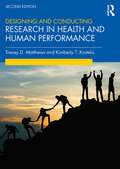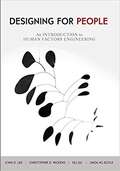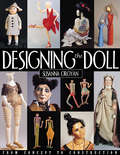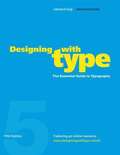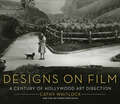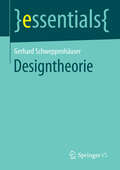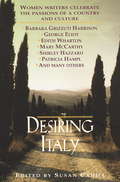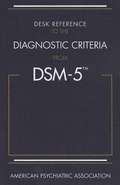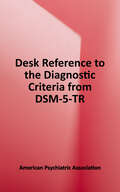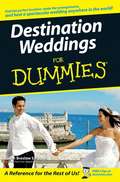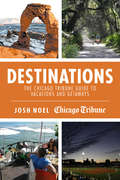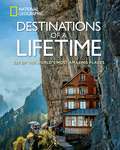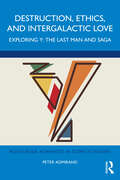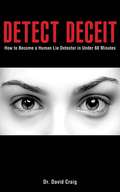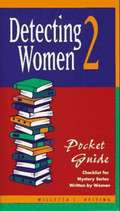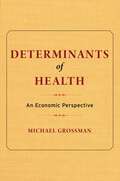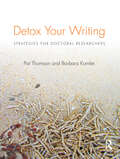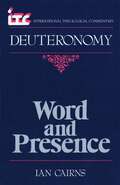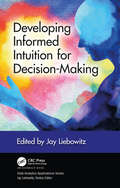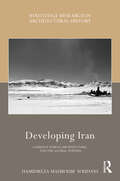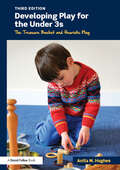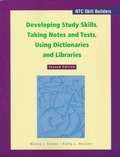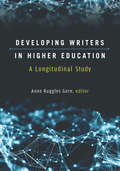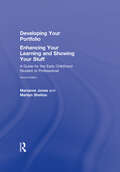- Table View
- List View
Designing and Conducting Research in Health and Human Performance
by Tracey D Matthews Kimberly T KostelisDesigning and Conducting Research in Health and Human Performance, 2nd edition shows students how to become effective producers and consumers of health and human performance research. Like the first edition, this edition provides comprehensive coverage of both quantitative and qualitative research methods and includes step-by-step guidance for writing effective research proposals and theses. In addition, the authors show how to read, assess, interpret, and apply published research and how to conduct basic studies in health, physical education, exercise science, athletic training, and recreation. In this edition, the authors have also expanded areas of research design to include the PICO (patient problem or population, intervention, comparison, and outcomes) technique. Designing and Conducting Research in Health and Human Performance, 2nd edition is filled with more up-to-date illustrative examples that emphasize the real-world applications of research methods. Throughout, the authors draw on a variety of examples that were selected because they provide a context to further the understanding of health and human performance research. Research to Practice examples and Tips are included by the authors to help students better appreciate the book’s content. Additionally, new to this edition, is Pulse Check, which provides an opportunity for students to engage in critical thinking in all things research. These study aids provide suggestions and additional resources to assist students in understanding the research process. Key terms, defined and highlighted, enrich each chapter. The end of each chapter includes Applying What You Learned sections designed to help students comprehend and follow best practices in research methods. Online resources and guides developed by the authors to support and enhance students’ learning of important research concepts are available.
Designing for People: An Introduction to Human Factors Engineering
by John Lee Christopher Wickens Yili Liu Linda BoyleWhether it is the car you drive or the app on your smartphone, technology has an increasingly powerful influence on you. When designed with people in mind, this influence can improve lives and productivity. <p><p>This book provides a broad introduction on how to attend to the needs, capabilities, and preferences of people in the design process. We combine methods of design thinking and systems thinking to understand people's needs and evaluate whether those needs are met. <p><p>This book also provides a detailed description of the capabilities and limits of people—both mental and physical—and how these can guide the design of everything from typography to teams and from data visualization to habits. The book includes: • Over 70 design principles for displays, controls, human-computer interaction, automation, and workspace layout• Integrative discussion of the research and theory underlying these guidelines, supported by over 1,000 references• Examples of successful and unsuccessful designs and exercises that link principles and theory to applications in consumer products, the workplace, and high risk-systems We hope this book will give a useful introduction to students entering the field and will also serve as a reference for researchers, engineers, and designers.
Designing the Doll: From Concept to Construction
by Susanna OroyanThe author of Anatomy of a Doll “gives us a gift by distilling the spirits found in doll/figure art . . . then explains the fundamentals to pave the way” (Barbara Campbell, editor of Soft Dolls & Animals!).Advance your dollmaking skills with this in-depth guide by master-dollmaker Susanna Oroyan! Susanna introduces you to her concept of “imaginative engineering” with a collection of design directions and technical processes that will help your ideas translate into reality.Expands on concepts presented in Anatomy of a Doll and Fantastic Figures.Covers a wide variety of construction methods, such as applications of wire armature in body construction, general concepts of mold making, sculpture mechanics, in-depth discussion of jointed figures, and methods of assembling your doll.More than 250 full-color photos of dolls from 130 of the world’s top doll artists. Over 200 detailed illustrations.Explains elements of design, such as focal point, scale, harmony, style, and the use of color, texture, and pattern. Learn techniques of proportion for working with the human figure.An excellent technical resource and reference book that will teach you how to develop ideas, then construct advanced art figures or dolls.“The doll world has only just recovered from the excitement of having Anatomy of a Doll which showed us what was possible. Now we can learn to get it with this new effort, the fabulous Designing the Doll. Thank you, Susanna, where would we be without you?” —Elinor Peace Bailey, author of Storytelling with Dolls“Demystifies the creation of dolls by offering techniques, basic construction and some very good thoughts on design . . . Filled with diagrams and color photos of dolls from some of the top contemporary doll-makers, inspiration is on every page.” —Polymer Clay
Designing with Type: The Essential Guide to Typography
by James Craig Irene Korol Scala William BevingtonThe classic Designing with Type has been completely redesigned, with an updated format and full color throughout. New information and new images make this perennial best-seller an even more valuable tool for anyone interested in learning about typography. The fifth edition has been integrated with a convenient website, www. designingwithtype. com, where students and teachers can examine hundreds of design solutions and explore a world of typographic information. First published more than thirty-five years ago, Designing with Type has sold more than 250,000 copies--and this fully updated edition, with its new online resource, will educate and inspire a new generation of designers.
Designs on Film: A Century of Hollywood Art Direction
by Cathy Whitlock The Art Directors GuildWho can forget the over-the-top, white-on-white, high-gloss interiors through which Fred Astaire danced in Top Hat? The modernist high-rise architecture, inspired by the work of Frank Lloyd Wright, in the adaptation of Ayn Rand's The Fountainhead? The lavish, opulent drawing rooms of Martin Scorsese's The Age of Innocence? Through the use of film design—called both art direction and production design in the film industry—movies can transport us to new worlds of luxury, highlight the ornament of the everyday, offer a vision of the future, or evoke the realities of a distant era. In Designs on Film, journalist and interior designer Cathy Whitlock illuminates the often undercelebrated role of the production designer in the creation of the most memorable moments in film history. Through a lush collection of rare archival photographs, Whitlock narrates the evolving story of art direction over the course of a century—from the massive Roman architecture of Ben-Hur to the infamous Dakota apartment in Rosemary's Baby to the digital CGI wonders of Avatar's Pandora.Drawing on insights from the most prominent Hollywood production designers and the historical knowledge of the venerable Art Directors Guild, Whitlock delves into the detailed process of how sets are imagined, drawn, built, and decorated. Designs on Film is the must-have look book for film lovers, movie buffs, and anyone looking to draw interior design inspiration from the constructions and confections of Hollywood. Whitlock lifts the curtain on movie magic and celebrates the many ways in which art direction and set design allow us to lose ourselves in the diverse worlds showcased on the big screen.
Designtheorie (essentials)
by Gerhard SchweppenhäuserDas essential bietet eine ideengeschichtliche Erkundung moderner Konzepte von Design. Es schlägt Positions- und Kursbestimmungen für ein zukunftsfähiges Design vor und diskutiert Aspekte des engen und des erweiterten Designbegriffs. Die Ambivalenz von Design zwischen Entwurf für den bestehenden Bedarf und Entwurf eines noch nicht Seienden wird philosophisch fruchtbar gemacht.
Desiring Italy
by Susan CahillUnder the spell of la dolce vita . . .For centuries Italy has been many things to many people. In this brilliant anthology and traveler's companion, twenty-eight first-rate women writers reveal why the land that is the heart and soul of European civilization is so seductive to women.Kate Simon walks us through a Siena filled with surprises and luminous beauty. Elizabeth Spencer writes of first coming to Italy and finding "home." Shirley Hazzard explores the mysteries of Naples. Muriel Spark writes on Venice, Edith Wharton on Rome, George Eliot on Florence, Barbara Grizzuti Harrison on San Gimignano, Patricia Hampl on Assisi. Other wonderful writers contemplate the idiosyncratic glories of Italy's architecture, cooking, art, and landscape; its culture; its places and people.As these writers tell their stories--in fiction, memoir, and essay--of coming to understand Italy, they explore the complexity of their passions for it, mingling affection and ecstasy with intellectual curiosity. Organized geographically--from northern Italy to Rome and on to the south, Desiring Italy offers an enchanting journey for readers and travelers.From the Trade Paperback edition.
Desk Reference to the Diagnostic Criteria From DSM-5
by American Psychiatric AssociationThe Desk Reference to the Diagnostic Criteria From DSM-5 is meant to be used in conjunction with the full DSM-5. Its proper use requires familiarity with the text descriptions for each disorder that accompany the criteria sets. This handy reference provides all ICD-9-CM and ICD-10-CM codes, coding notes, and recording procedures included in DSM-5. Clinicians will find additional reference information in DSM-5, including Section III: Emerging Measures and Models (containing assessment measures, cultural formulation and interviews, an alternative DSM-5 model for personality disorders, and conditions for further study) and the DSM-5 Appendix (containing highlights of changes from DSM-IV, glossaries of technical and cultural terms, and alphabetical and numerical listings of DSM-5 diagnoses and codes).
Desk Reference to the Diagnostic Criteria from DSM-5-TR
by American Psychiatric AssociationThe Desk Reference to the Diagnostic Criteria From DSM-5-TR is a concise, affordable companion to the ultimate psychiatric reference, DSM-5-TR. It includes the fully revised diagnostic classification, as well as all the diagnostic criteria from DSM-5-TR in an easy-to-use format. This handy reference provides quick access to the information essential to making a diagnosis. Designed to supplement DSM-5-TR, this convenient guide will assist all mental health professionals as they integrate the DSM-5-TR diagnostic criteria into their diagnoses. The Diagnostic and Statistical Manual of Mental Disorders stands alone as the most authoritative reference available for clinical practice in the mental health field. The Desk Reference to the Diagnostic Criteria From DSM-5-TR distills the most crucial, updated diagnostic information from this volume to provide clinicians with an invaluable resource for effectively diagnosing mental disorders, ranging from the most prevalent to the least common.
Destination Weddings For Dummies
by Susan Breslow SardoneWant to have a wonderful wedding away from home? Destination Weddings For Dummies is your all-in-one guide to getting married out of town, giving you savvy tips on everything from making travel arrangements to hiring vendors to dressing the wedding party.Fron Vegas to the Vatican, this hands-on, practical resource helps you arrange a unique, unforgettable wedding anywhere in the world. Focusing on the various ways you can use the Internet in your planning, Destination Weddings For Dummies is filled with Web tips, shortcuts, and URLs, as well as instructions for creating your own digital wedding planner. You'll see how to establish a realistic wedding budget and get your friends and family on board. Then, you'll choose the perfect location; from Europe to the tropics to the open sea, we've done the scouting for you! You'll also discover how to:Get married legally around the worldKnow who, when, and how to inviteCreate your own destination wedding Web site and blogFit all the basics into your budget-- from flowers and catering to the rings, photography, and musicHire wedding pros from a distanceDecide on your ceremony's styleDress the bride, groom, and the wedding partyCommunicate your plans to invited guestsCompare wedding packagesSave money on travel arrangementsTest-drive your destination wedding siteOrganize fun wedding activitiesHandle various wedding emergenciesIf money is no object, you'll also see how to host a blowout wedding and make a splash when you splurge. Whether it's a small, intimate ceremony in a Hawaiian garden or a large gathering on a yacht in the Mediterranean, Destination Weddings For Dummies is all you need to get married anywhere you choose with ease and in style!
Destinations
by Josh NoelDestinations is a helpful, insightful collection of columns from Chicago Tribune travel writer Josh Noel, covering a wide range of expertly curated getaways. Focusing mostly on US locations, but with beautiful international locales sprinkled in, Noel gives a critical and off-the-beaten path view of an eclectic group of vacation spots.Noel offers useful recommendations on weekend jaunts and week-long excursions, mixing in both affordable and ultra-luxurious options, including spas, skiing, Sundance, and the French Riviera. With options like microbrewery tours in Colorado and a Tibetan cultural center in Indiana, Noel uncovers what the average travel guide misses. Additionally, each article includes tips on hotels, restaurants, and travel arrangements.Whether readers are looking for a pleasant nature walk, rugged camping trip, or a city's top under-the-radar hotspots, Destinations is the perfect interactive travel guide.
Destinations of a Lifetime: 225 of the World's Most Amazing Places
by National GeographicHundreds of oversized images of the world's most spectacular destinations are featured along with service information on the best and most authentic ways to experience them. A candy box full of visual delights, this book will inspire tangible ideas for everyone's next great trip. National Geographic takes you on a photographic tour of our world in this spellbinding new coffee table travel gift book. Hundreds of Earth's most breathtaking locales are illustrated with vivid, oversized full-color images taken by Nat Geo's world-class photographers. These images, coupled with evocative text, feature a plethora of visual wonders: ancient monoliths, scenic islands, stunning artwork, electric cityscapes, white-sand seashores, rain forests, ancient cobbled streets, and both classic and innovative architecture. Loaded with hard service information for each location, Destinations of a Lifetime has it all: when to go, where to eat, where to stay, and what to do to ensure the most enriching and authentic experience.
Destruction, Ethics, and Intergalactic Love: Exploring Y: The Last Man and Saga (Routledge Advances in Comics Studies)
by Peter AdmirandDestruction, Ethics, and Intergalactic Love: Exploring Y: The Last Man and Saga offers a creative and accessible exploration of the two comic book series, examining themes like nonviolence; issues of gender and war; heroes and moral failures; forgiveness and seeking justice; and the importance of diversity and religious pluralism. Through close interdisciplinary reading and personal narratives, the author delves into the complex worlds of Y and Saga in search of an ethics, meaning, and a path resonant with real-world struggles. Reading these works side by side, the analysis draws parallels and seeks common themes around the four central ideas of seeking and making meaning in a meaningless world; love and parenting through oppression and grief; peacefulness when surrounded by violence; and the perils and hopes of diversity and communion. This timely and thoughtful study will resonate with scholars and students of comic studies, media and cultural studies, philosophy, theology, literature, psychology, and popular culture studies.
Detect Deceit: How to Become a Human Lie Detector in Under 60 Minutes
by David CraigIt doesn't take mind reading superpowers to be able to tell when someone is lying-but it does take special skills and a little practice. In Detect Deceit, David Craig, an international expert in undercover operations, provides readers with an easy-to-follow guide on applying lie detection skills to your everyday life. From bargaining, making a purchase, or dealing with children, to the more serious issues of negotiating a contract or identifying infidelity, Craig delivers simple but effective tips and techniques we can all use to see behind the façade and get to the truth. Split into three parts, the book looks at the nature of lying and how to detect lies, and includes an easy reference section that summarizes all the main points. Lying is a normal part of human communication and sometimes is necessary to protect someone's feelings, but there are also hurtful lies meant to deceive. You can't always rely on what comes out of someone's mouth. With fullcolor photographs and practical examples, Detect Deceit provides anyone with the tools to be a human lie detector. The mystery of what a person is really thinking is finally unlocked in this fascinating and informative book.
Detecting Women 2: Pocket Guide Checklist for Mystery Series Written by Women
by Willetta L. HeisingIf you love the Fantastic Fiction website, you'll love Detecting Women 2. It's a small book of lists of series of women detectives with the authors and the books in the series. More than 600 series detectives created by women. Over 3400 mystery titles in correct series order.
Determinants of Health: An Economic Perspective
by Michael GrossmanThis collection of Michael Grossman’s most important papers adds essential background and depth to his work on economic determinants of public health. Each of the book’s four sections includes an introduction that contextualizes the issues and addresses the larger stakes of his work. An afterword discusses the significance of Grossman’s approach for subsequent research on health economics, as well as the work others have done to advance and extend his innovative perspective.Determinants of Health explains how the economic choices people make influence health and health behaviors. It begins with a section on the theoretical underpinnings and empirical results of Grossman’s groundbreaking health economics model, first introduced in the 1970s, followed by essays on the relationship between health and schooling; determinants of infant health, with a special emphasis on public policies and programs; and the economics of unhealthy behaviors. Grossman treats health as a form of human capital. He shows that public policies and programs that determine the price and availability of key inputs have critical effects on outcomes ranging from birth weight and infant mortality to cigarette smoking, alcohol abuse, illegal drug use, and obesity. Grossman’s approach has led to a major stream of literature in the field, sparking contributions by the world’s leading health economists, including Joseph Newhouse, Jonathan Gruber, Amy Finkelstein, Michael Greenstone, and David Cutler. His clarity on the role that economics play in people’s good and bad health choices is immensely valuable to the debate over how we legislate and spend on health.
Detox Your Writing: Strategies for doctoral researchers
by Pat Thomson Barbara KamlerThere are a number of books which aim to help doctoral researchers write the PhD. This book offers something different - the scholarly detox. This is not a faddish alternative, it’s not extreme. It’s a moderate approach intended to gently interrupt old ways of doing things and establish new habits and orientations to writing the PhD. The book addresses the problems that most doctoral researchers experience at some time during their candidature – being unclear about their contribution, feeling lost in the literature, feeling like an imposter, not knowing how to write with authority, wanting to edit rather than revise. Each chapter addresses a problem, suggests an alternative framing, and then offers strategies designed to address the real issue. Detox Your Writing is intended to be a companionable work book – something doctoral researchers can use throughout their doctorate to ask questions about taken-for-granted ways of writing and reading, and to develop new and effective approaches. The authors’ distinctive approach to doctoral writing mobilises the rich traditions of linguistic scholarship, as well as the literatures on scholarly identity formation. Building on years of expertise they place their emphasis both on tools and techniques as well as the discursive practices of becoming a scholar. The authors provide a wide repertoire of strategies that doctoral researchers can select from, rather than a linear lock step progression through a set of exercises. The book is a toolkit but a far from prescriptive one. It shows that there are many routes to developing a personal academic voice and identity and a well-crafted text. With points for reflection alongside examples from a broad range of disciplines, the book offers thinking tools, writing tools, linguistic tools, and reading tools which are relevant to all stages of doctoral research. This practical text can be used in all university doctoral training and composition and writing courses. However, it is not a dry how-to-do–it manual that ignores debates or focuses solely on the mechanical at the expense of the lived experience of doctoral research. It provides a practical, theorised, real-world, guide to postgraduate writing.
Deuteronomy: Word and Presence
by Ian CairnsIn this commentary Ian Cairns presents Deuteronomy as a slowly evolving, complex composite — as legal code, as treaty text or covenant, as Moses' farewell speech, and as the final volume of the Pentateuch. Despite Deuteronomy's structural complexity, however, Cairns shows how the theme "Word and Presence" permeates the entire book: God is the living Presence who can be encountered and known through his word addressed to each generation in turn. This commentary is unique in its emphasis on the theology of Deuteronomy (e.g., law as "humane instruction") as well as in its modern applications and illustrations from non-Western cultures.
Developing Career and Living Skills
by Barb Terry Howe Mary Sue Burkhardt"What do you want to do with your life?" "What do you want to be when you grow up?" How many times have you already heard these questions? Do you have an answer yet? Do you know there really is no right answer? The only person who can answer those questions is YOU! Who are you? Where are you going? What's important to you? When will something happen? Your answers to these questions will determine much of your life's direction. This textbook, Developing Career and Living Skills, gives you an opportunity to look into yourself and answer those questions in ways that will enable you to achieve your highest dreams.
Developing Informed Intuition for Decision-Making (Data Analytics Applications)
by Jay LiebowitzThis book examines how to develop the main traits that are necessary to become an “informed intuitant”. Case studies and examples of successful “informed intuitants” are a major component of the book. “Intuitant” is someone who has the intuitive awareness to be successful. “Informed intuitant” indicates that the individual/decision maker not only applies his/her intuition but also verifies it through using data-driven approaches (such as data analytics). Some of this work resulted from research examining how well do executives trust their intuition.
Developing Iran: Company Towns, Architecture, and the Global Powers (Routledge Research in Architectural History)
by Hamidreza Mahboubi SoufianiThis book examines the emergence of modern company towns in Iran by delineating the architectural, political, and industrial histories of three distinct resource-based ‘company town’ projects built in association with the ‘Big Three’ powers of World War II. The book’s narrative builds upon a tripartite research design that chronologically traces the formation and development of the oil, steel, and copper industries, respectively favoured by Great Britain, the Soviet Union, and the United States in this part of the world. By applying three sets of comparative studies, the book provides critical vantage points to three different ideological design paradigms: postcolonial regionalism, socialist universalism, and rationalist modern nation building. From a global political context, the book contributes to the disclosure of new information about the geopolitical confrontation of these three nations in the Global South to increase their sphere of influence after the Second World War. Furthermore, it demonstrates how postwar architectural modernism was adopted by each power and adapted to their ideological mind frame to fulfil distinct social, cultural, political, and economic targets. This book examines multiple interconnections between architecture, politics, and industrial development by adopting a transdisciplinary approach based on comprehensive fieldwork, site surveys, and the analysis of original multilingual documents. As such, it will be of interest to researchers and students of architecture, history, international relations, and Middle Eastern studies.
Developing Play for the Under 3s: The Treasure Basket and Heuristic Play
by Anita M. HughesWe currently live in a two dimensional world of tapping and sliding fingers on screens, but babies and young children need to touch, taste, smell, shake and bang three dimensional objects in order to develop thinking and learning skills. The Treasure Basket and Heuristic play approach is all about offering natural and household objects to babies and young children to play with. This simple approach promotes extraordinary capacities of concentration, intellectual curiosity and manipulative mastery. Full of resource ideas and activities, this book offers accessible explanations of how the under 3’s think and learn, step by step guidance for setting up play sessions and descriptions of the best materials to offer. Featuring original interviews between the author and Elinor Goldschmied, who was the pioneer of the Treasure Basket and Heuristic Play, this third edition of Developing Play for the Under 3s has been thoroughly updated to include: A new chapter with case studies to show how Heuristic Play can be offered to the 2-4 year olds. A new chapter exploring the myths and misunderstandings of this approach. Links to the Forest School movement. Research evidence supported by case studies. The characteristics of effective learning and how the Treasure Basket and Heuristic Play promote these. Information about the Froebel Archive project, bringing the story of Elinor Goldschmied’s work alive through film. Based on a wealth of research into how babies learn and the principles of learning, together with the author’s own personal experience of working with the under 3s, this book will be indispensable for anyone involved in the care and development of children in this age group.
Developing Study Skills, Taking Notes and Tests, Using Dictionaries and Libraries
by Marcia J. Coman Kathy L. HeaversWere you ever taught how to study? Instructors often assume that students beyond grade school know and use good study techniques. You may know some people who seem to be able to do more in less time and get good grades besides. How do they do it? In this unit you will learn some simple techniques that good students consider most important when studying. Now you can discover some of their secrets.
Developing Writers in Higher Education: A Longitudinal Study (Sweetland Digital Rhetoric Collaborative)
by Anne R GereFor undergraduates following any course of study, it is essential to develop the ability to write effectively. Yet the processes by which students become more capable and ready to meet the challenges of writing for employers, the wider public, and their own purposes remain largely invisible. Developing Writers in Higher Education shows how learning to write for various purposes in multiple disciplines leads college students to new levels of competence. This volume draws on an in-depth study of the writing and experiences of 169 University of Michigan undergraduates, using statistical analysis of 322 surveys, qualitative analysis of 131 interviews, use of corpus linguistics on 94 electronic portfolios and 2,406 pieces of student writing, and case studies of individual students to trace the multiple paths taken by student writers. Topics include student writers’ interaction with feedback; perceptions of genre; the role of disciplinary writing; generality and certainty in student writing; students’ concepts of voice and style; students’ understanding of multimodal and digital writing; high school’s influence on college writers; and writing development after college. The digital edition offers samples of student writing, electronic portfolios produced by student writers, transcripts of interviews with students, and explanations of some of the analysis conducted by the contributors. This is an important book for researchers and graduate students in multiple fields. Those in writing studies get an overview of other longitudinal studies as well as key questions currently circulating. For linguists, it demonstrates how corpus linguistics can inform writing studies. Scholars in higher education will gain a new perspective on college student development. The book also adds to current understandings of sociocultural theories of literacy and offers prospective teachers insights into how students learn to write. Finally, for high school teachers, this volume will answer questions about college writing.
Developing Your Portfolio - Enhancing Your Learning and Showing Your Stuff: A Guide for the Early Childhood Student or Professional
by Marianne Jones Marilyn SheltonPortfolios have often been used as a way for teachers to monitor and assess their students' progress, but this book picks up on the current trend of using portfolios to assess teachers themselves as part of their degree requirements. As a professional development tool, portfolios are also useful for classroom teachers in evaluating their practice, and in showcasing their skills and accomplishments for use in interviews.Veteran teacher educators Marianne Jones and Marilyn Shelton provide practical and comprehensive guidance specific to the needs of pre- and in-service teachers of young children. This thoroughly revised and updated new edition features: A flexible and friendly approach that guides students at varying levels of experience through the portfolio process. New material on the portfolio planning stage and additional coverage on the importance of developing a personal philosophy. A companion website with additional instructor materials such as printable templates, exercises for improving portfolio skills, and more. Both theoretical and practical, the book addresses issues and mechanics related to process and product, instruction and guidance techniques, the role of reflection, and assessment strategies. With concrete examples, rubrics, tips, and exercises, this book will provide a step-by-step guide to creating a professional teaching portfolio.
